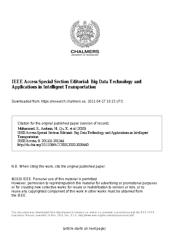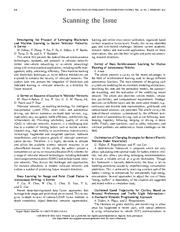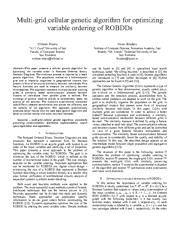A copy of this work was available on the public web and has been preserved in the Wayback Machine. The capture dates from 2020; you can also visit the original URL.
The file type is application/pdf.
Filters
An Evolutionary Hierarchical Interval Type-2 Fuzzy Knowledge Representation System (EHIT2FKRS) for Travel Route Assignment
[article]
2018
arXiv
pre-print
The present research paper suggests an innovative advanced traffic management system based on Hierarchical Interval Type-2 Fuzzy Logic model optimized by the Particle Swarm Optimization (PSO) method. ...
The experimental results proved the effectiveness of learning the Hierarchical Interval type-2 Fuzzy logic using real time particle swarm optimization technique PSO to accomplish multiobjective optimality ...
This pa-per proposes a Hierarchical Interval Type-2 Fuzzy Knowledge Representation System (HIT2FKRS) based on Particle Swarm Optimization for Travel Route Assignment. ...
arXiv:1812.01893v1
fatcat:3ao7h4trcbdkzkkfkqzx73e5im
Integration of Multi-Criteria Decision Support with Infrastructure of Smart Services for Sustainable Multi-Modal Transportation of Freights
2021
Sustainability
We present the steps of extension of the structure of the knowledge-based system with a multi-criteria decision support method, and the possibilities to work under the conditions of wireless networks and ...
The objectives are forwarded to construct the multi-criteria decision-making components and integrate them into the multi-layered, computer-based information management of intelligent systems. ...
How such type of BDI agent architecture is applicable for the multi-modal transportation domain is represented in Figure 2 . ...
doi:10.3390/su13094675
doaj:26ece80683df47aea0ba0c248583b4fe
fatcat:p4oi2wfjuzfotceax4d5pob5i4
Adapt-Traf: An adaptive multiagent road traffic management system based on hybrid ant-hierarchical fuzzy model
2014
Transportation Research Part C: Emerging Technologies
This paper proposes an adaptive multiagent system based on the ant colony behavior and the hierarchical fuzzy model. ...
The proposed system is implemented and simulated under a multiagent platform in order to discuss the improvement of the global road traffic quality in terms of time, fluidity and adaptivity. ...
level of certainty -No results for real networks -Minimize the perceived travel delays Balaji and Srinivasan (2011) Urban traffic management -Multi-agent system based on type-2 fuzzy decision module - ...
doi:10.1016/j.trc.2014.03.003
fatcat:sahnsazdlvevvoplvgofad4hvy
Multi-agent based vehicular congestion management
2011
2011 IEEE Intelligent Vehicles Symposium (IV)
The paper classifies the multi-agent techniques based on the locus of decision control intelligence and focuses on their suitability of application in congestion management. ...
The autonomous and distributed nature of multi-agent systems is well-suited to the transportation domain which is dynamic and geographically distributed. ...
System (RoSFuzMAS) approach in [36] consists of a City Agent, Road-side Agent (RSA) and Intelligent Vehicle Agent (IVA) and uses a hierarchical fuzzy inference engine for optimal route computation. ...
doi:10.1109/ivs.2011.5940493
dblp:conf/ivs/DesaiLDS11
fatcat:hl6wvy6n2rdnhn67j4dtzztchy
Review of Data Fusion Methods for Real-Time and Multi-Sensor Traffic Flow Analysis
2021
IEEE Access
[121] highlight a local and supervisory agent concept in a hierarchical-based multi-agent system. ...
A local agent has the capability to perform the best control based on the decision made within limited knowledge exploration, while a supervisory agent has a long-term learning experience to provide the ...
doi:10.1109/access.2021.3069770
fatcat:2p52c7psrzhofgy4l2jy5fxw4u
Design of an Optimal ANFIS Traffic Signal Controller by Using Cuckoo Search for an Isolated Intersection
2015
2015 IEEE International Conference on Systems, Man, and Cybernetics
fuzzy controller with a predefined rule base, then enhancing to type-1 ANFIS and type-2 ANFIS controller. ...
Applying type-2 fuzzy logic systems and the recently introduced cuckoo search optimization method led to the development of an efficient traffic signal timing controller, which is extended for a network ...
In their research they developed a multiagent distributed architecture signal control system based on type-2 FLS. All agents were homogeneous and had equal decision making capabilities. ...
doi:10.1109/smc.2015.363
dblp:conf/smc/AraghiKC15
fatcat:uwxsjl42hfh4ld4vc5z2czeeli
Edge-based V2X communications with Big Data Intelligence
2020
IEEE Access
First, the Hierarchical edge-based preemptive route creation is introduced to create hierarchical edges and conduct efficient packet forwarding as well as route aggregation. ...
In this article, we propose a scheme that enhances V2V communications through integration of vehicle edge-based forwarding and learning-based edge selection policy optimization. ...
in that the simple mapping approach is insufficient for representing the complex decision making. ...
doi:10.1109/access.2020.2964707
fatcat:mohrdx36xretpfuh4kagxbha4m
Performance evaluation of cost-based vs. fuzzy-logic-based prediction approaches in PRIDE
2008
Unmanned Systems Technology X
PRIDE (PRediction In Dynamic Environments) is a hierarchical multi-resolutional framework for moving object prediction. ...
The second is a fuzzy-logic-based approach that deals with the pervasive presence of uncertainty in the environment to negotiate complex traffic situations. ...
Vehicle C has to consider vehicles A and B and thus makes a decision based on the paths that these vehicles plan to take. ...
doi:10.1117/12.779601
fatcat:cibzi5zrtze3blnicdrdktbrxy
A hierarchical, multi-resolutional moving object prediction approach for autonomous on-road driving
2004
IEEE International Conference on Robotics and Automation, 2004. Proceedings. ICRA '04. 2004
In this paper 1 , we present a hierarchical multiresolutional approach for moving object prediction via estimation-theoretic and situation-based probabilistic techniques. ...
The results of the prediction are made available to a planner to allow it to make accurate plans in the presence of a dynamic environment. ...
CONCLUSIONS AND FUTURE WORK In this paper, we described a hierarchical, multi-resolutional approach for moving object prediction during autonomous on-road driving. ...
doi:10.1109/robot.2004.1308110
dblp:conf/icra/SchlenoffMB04
fatcat:uv4tq4esg5cchleqm6pn2r74y4
Prioritization of Exigency Services in Multi-Agent Transportation Systems
2023
VFAST Transactions on Software Engineering
Multi-agent system helps in achieving a single global goal by working on different tasks in a distributed environment. ...
We operate the signal based on their priorities for exigency vehicles with different priorities. ...
Multi-agent System works on the principle of combining and coordinating the knowledge of every single agent to find the optimal solution for the problem [2] . ...
doi:10.21015/vtse.v11i1.1353
fatcat:qqagxwwgkvbzzcbhmlgzxm7wh4
IEEE Access Special Section Editorial: Big Data Technology and Applications in Intelligent Transportation
2020
IEEE Access
systems where sensors and mobile devices can gather information and cloud computing, allowing knowledge discovery, information sharing, and supported decision making. ...
control a multi-agent system (MAS) with multiple under-driven automated guided vehicles (AGVs) based on flexible sampling periods and changing communication topology. ...
doi:10.1109/access.2020.3035440
fatcat:r3i3wkhttndbjnyciux3xuny3a
Scanning the Issue
2022
IEEE transactions on intelligent transportation systems (Print)
The authors take into account the integration of blockchain and federated learning in vehicular networks as a direction for future research. ...
state-of-the-art communication technologies, standards, and protocols in vehicular networks (either inter-vehicle networking or in-vehicle networking) along with several practical applications, including traffic ...
PSO-Based Adaptive Hierarchical Interval Type-2 Fuzzy Knowledge Representation System (PSO-AHIT2FKRS) for Travel Route Guidance M. Zouari, N. Baklouti, J. Sanchez-Medina, H. M. Kammoun, M. B. ...
doi:10.1109/tits.2022.3141513
fatcat:gvywr655cvgolg7rfjrqmt33b4
Multi-grid cellular genetic algorithm for optimizing variable ordering of ROBDDs
2012
2012 IEEE Congress on Evolutionary Computation
This paper presents a cellular genetic algorithm for optimizing the variable order in Reduced Ordered Binary Decision Diagrams. The evolution process is inspired by a basic genetic algorithm. ...
The population evolves on a bidimensional grid and is implicitly organized in geographical clusters that present a form of structural similarity between individuals. ...
Karnik-Mendel Algorithm Computation for the Centroid of an Interval Type-2 Fuzzy Set 149, Syibrah Naim and Hani Hagras, A Hybrid Approach for Multi-Criteria Group Decision Making Based on Interval Type ...
doi:10.1109/cec.2012.6256590
dblp:conf/cec/RotaruB12
fatcat:4ly3nrktw5habc6lf5err7d5py
Self-Organization in Traffic Lights: Evolution of Signal Control with Advances in Sensors and Communications
[article]
2017
arXiv
pre-print
Our research results indicate that, while many sophisticated techniques have attempted to improve the scheduling of traffic signal control, either real-time sensing of traffic patterns or a priori knowledge ...
Given the trend towards interconnectivity, it is only a matter of time before vehicles communicate with one another and with infrastructure. ...
In their formulation the road network is hierarchically organized with multi-level decision analysis.Tatomir and Rothkrantz [164] propose a dynamic traffic routing algorithm based on Ant Colony Optimization ...
arXiv:1708.07188v1
fatcat:nojqrol46ndull6hoaoq7blu2m
Semantic agent-based controls for Service Oriented Architecture (SOA) enabled Intelligent Transportation Systems (ITS)
2011
2011 14th International IEEE Conference on Intelligent Transportation Systems (ITSC)
(Balbo & Pinson, 2005) This is a multi-agent based Distributed Decision Support System for urban public transportation system management. ...
Agent-based modelling and simulation Agent-based modelling (ABM) and simulation uses multi-agent systems for the representation of social, economic, ecological and other similar systems in a software environment ...
Technologies Review
Multi-Agent communication using Agent Communication Language (ACL) ACL is based on KQML. ...
doi:10.1109/itsc.2011.6083112
dblp:conf/itsc/KamranH11
fatcat:5mulhguh3jcbhjlxucwderdfou
« Previous
Showing results 1 — 15 out of 1,219 results















